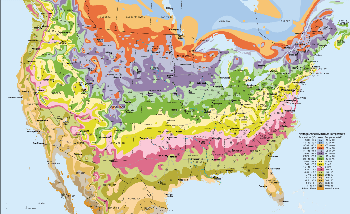When choosing perennial plants you'll need to consider their hardiness rating, your planting location, and when they flower so you'll have season-long color.
 Hardiness Ratings
Hardiness Ratings
To help gardeners choose plants, various systems of rating hardiness have been developed. A plant is considered hardy in a region if it can grow and thrive there without requiring special protective measures such as an insulating straw mulch.
The USDA Hardiness Zone Map divides the country into regions based on the average minimum winter temperature. Always check the hardiness rating of a plant you are considering, and compare it to the zone you're in. If you live in USDA Zone 5 (minimum winter temperature -20°F), choose plants that are rated to Zone 5 or lower. If you choose plants rated to Zone 6 (-10°F) or zone 7 (0°F), you are likely to lose plants to freezing injury.
You may be able to grow plants rated to one zone warmer than yours if you live in a particularly warm spot, such as near a large body of water, or if you place the plants in a sheltered place where they're protected from strong winds. However, if you are just starting out with perennials, why take the chance? Choose plants that are reliably hardy.
Sun or Shade
After hardiness, sunlight is your most important consideration. Choose plants that are adapted to the light levels in your garden. Don't plant sun lovers under dense trees, and don't plant shade lovers where they'll be exposed to blazing mid-day sun. Plant catalogs, labels, and resource books all give the light preferences for plants, so take these to heart. You may be able to grow a sun lover in partial shade, but you may get fewer flowers or weaker growth. Place it in a spot where it can really shine!
Planning for Continuous Bloom
Most perennial plants have a distinct bloom period, lasting anywhere from a week to a month or more. Plant descriptions usually include an approximate bloom time, such as "early summer" or "autumn." A few will describe certain plants as continuous bloomers, but even these usually have a period of peak bloom. When planning your garden, consider bloom times carefully. If you mistakenly choose all early summer bloomers, you may be disappointed when there's only foliage in your garden from midsummer on.
Adventurous gardeners can even plan their gardens so that the color scheme changes throughout the growing season. You might start out with cooler pastels in the springtime, then choose vibrant colors for your summer-flowering perennials. Fall might include plants with complementary colors.
Perennial plants take some time to get established. You may get a few flowers in the first season, depending on the size of the plant you've purchased, but you'll need to wait a season or two for the real show to begin. Plan to add some annual flowers to your new perennial beds to carry you through the first growing season.